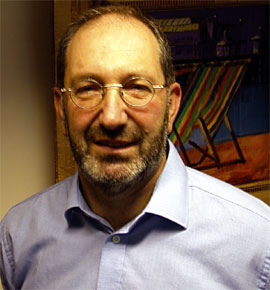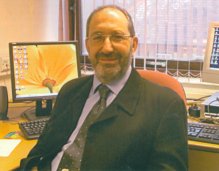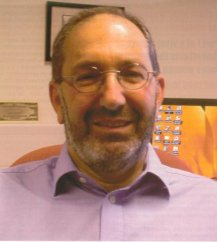This interview is with Dr Mike Brada, for CANCERactive and was originally published in February 2004 icon

A hundred years ago Marie and Pierre Curie were jointly awarded the Nobel Prize for Physics.
Just before their marriage in 1895, Pierre had sketched out romantic plans for their future.
Settling in Paris, the mother and father of radioactive invention would "spend life side by side, in the sway of our dreams".
But alas, developing the use of radium to treat malignant tumours proved a harshly exacting reality. The Curies toiled away in a freezing lab that one chemist likened to a stable or a potato cellar.
Their fingers were constantly burned by radium. Weakened by constant exposure to radiation. Pierre was run over and killed by a car in 1906.
Marie died of leukaemia in 1934, but not before training 150 women as x-ray manipulators and recording her real joy at "easing human suffering".
A century on, icon felt it timely to check out just how radiotherapy has developed technically and where it fits alongside surgery and chemotherapy as a state-of-the-art treatment for cancer.
At the Royal Marsden Hospital in Fulham, we caught up with Dr Mike Brada, Reader and Consultant in Clinical Oncology. Like the Curies in their time, Czech-born Dr Brada is an eminent scientist and committed humanitarian who runs packed clinics, as well as a UK research group (with the National Cancer Research Institute) mounting large scale trials on brain tumours. He’s on the advisory board of the Samantha Dickson Research Trust and is also the current President of ESTRO, the European Radiotherapy Society of 6000 members - radiation oncologists, physicists, radio-biologists and radiographers. ESTRO’s office in Brussels is just one of many international pit stops in his busy diary. Also an active clinician, Dr Brada is officially an academic funded by the Institute of Cancer Research. But personable, precise, bearded and dapper in his dark suit he looks a little like medicine’s answer to Steven Spielberg, He cycles to work most days, plays the flute and, off-duty, enjoys tennis, skiing and country walks with his wife, 15 year old daughter and son of 12.

He looks a little like medicine’s answer to Steven Spielberg

We tend to think of consultants as synonymous with "specialists"; medical dignitaries who dedicate their careers to one particular designated field. Mike Brada, however, bucks the trend, having changed course several times over 20 years at the Marsden, pursuing research into different cancer conditions wherever he perceived that treatment could be refined and optimised. Mike has worked with lymphomas and testicular cancer, spent some 15 years improving care for brain tumour patients and is now turning his interests to radiotherapy research for sufferers of non small-cell lung cancer.
Mike’s passion for medicine is second generation; his Czech father was a physician and radiologist, his mother a paediatrician. But his planned entre into medical school was disrupted when in 1968 the Russians moved in to Prague. At 18 Mike came here to study at Bristol University instead - and stayed. He jokes that he’s a "late developer" because it was only six years after qualifying that he ultimately chose a complete shift from haematology "which I felt was limited to the laboratory component, whereas I was already most interested in lymphoma and leukaemia" to work on "the broader plane" of radiation oncology. His late start has brought thousands of patients long-term gains in quality of life and cure.
Q:
What was your first research success after coming to the Marsden?
A:
In 1985, still in the early days of gene rearrangement in lymphoma, I was looking to detect small amounts of disease using molecular diagnostic techniques. We found that a proportion of patients who had otherwise localised lymphoma actually also had lyrnphoma cells circulating in their blood.
Now common knowledge, this was relatively new at the time, because the technique to find it was very sensitive. What we call gene rearrangement involves taking blood which you spin down to take the DNA out to see if it contains any tumour cells. If any are circulating, you could then tell that the patient needed more systemic than localised treatment.
Q:
In the medical world is there any sense of radiotherapy versus chemotherapy - two forms of treatment in competition for prime place?

I’m personally interested in the whole breadth of oncology

A:
As a clinical oncologist, I’m personally interested in the whole breadth of oncology. In this country radiotherapy has been, and still is, the major oncological speciality. In the UK - as in a handful of other countries - the clinical oncologist delivers both radiotherapy and chemotherapy which gives us a chance to be slaves of neither one nor the other modality.
Q:
What brought you into work with brain tumours?
A:
In the late eighties I took over from a retiring colleague who had pioneered the treatment of children with brain tumours. I set up a clinical and research unit to develop new treatments for these tumours and from an inauspicious start we have become quite an influential investigative group. In the very early days of radio-surgery (non-invasive radiation treatment to shrink turnours), when people were starting to use the gamma knife and then the second generation, linear accelerator, we became aware that this was a potentially useful high-precision technique for treatment of brain tumours. The gamma knife is a multi-headed cobalt unit that cornered the market and gave rise to its own medical industry, with a lot of marketing around it. Forerunners in radio-surgery regarded it as so precise that it wouldn’t affect any "normal brain" surrounding the targeted tumour and that therefore the radiation could be given in a single high dose. Actually they could only deliver the radiation as a single fraction because that’s how the machines were set up and the treatment was limited to very small tumours. People receiving treatment had their heads bolted in a fixed frame under local anaesthetic, and the procedure could only be done as a one-off. In the early days, this work was actually done by surgeons, who, according to their training, saw the procedure as a single, high-dose, one-off operation. They thought that’s what you had to do.
Q:
But you found otherwise?
"
A:
We did quite a lot of work to show that normal surrounding brain receives some radiation anyway. You can’t avoid it, whatever technique you use, and the larger the lesion, the more normal brain tissue is affected. But there’s a well-known principle that treatment in multiple small doses is safer to normal tissue and here at the Marsden we began to think about combining this so-called "fractionated" treatment with the precision of stereotactic irradiation. Hence the term fractionated stereotactic radiotherapy. It became obvious that with linear accelerator instead of the gamma knife, you could do the same for patients and much more. Linear accelerator (sometimes called linac) is standard equipment and basically produces precision high-energy x-rays from electricity. Linac is able to move around the head and can more or less achieve any position. It allows you to treat larger tumours and irregularly shaped tumours, which most if not all tumours are.

We developed a way of treating them from multiple directions and - using very high precision CT and MRI scan information in 3D - to conform the radiotherapy so that it follows the shape of the individual tumour. We also worked with a neurosurgeon from the National Hospital (now working in Bristol), Steve Gill, on developing a head frame that didn’t have to be fixed with screws, and was therefore removable and relocatable. Its very simple, fixed to the head with straps and fitted by the patients dental impression. We were in on the very early development of fractionated stereotactic radiotherapy (FSRT). Whereas other American and European centres bought their equipment at great expense when it became commercially available, we developed some of ours in-house and collaborated on the development with the manufacturer so that it cost us nothing but the efforts of our very enthusiastic team. I think that we were certainly the first in Europe to offer FSRT if not the first in the world. We currently treat about 150 patients a year, some with only five or six fractions, some up to 30, over a period between one and six weeks
Q:
What do you see as the next technical advance?
A:
Here at the Marsden we have a number of European and world headers in IMRT or Intensity Modulated Radiotherapy, where instead of just changing the shape of the beam, you can actually change the intensity, as you treat different parts of the tumour. Our recently completed study shows that stereotactic IMRT is in fact no better for treating benign brain tumours than conventional stereotactic radiotherapy. But I"m now looking at its application for some specific brain tumours and for lung cancer
Q:
How much of a team effort is the delivery of FSRT?
A:
Very much. I see the patient decide on the best treatment and define exactly which area needs to be treated The physicists here plan the treatment sitting by the computer and then provide the precise delivery links between the computer and the machine. The actual reatment is delivered by radiographers who know how to position and direct the machine to the prescription I give. In the clinic we have research fellows working constantly on technique development and research nurses and research managers to collect the data.
Q:
How many similar centres are there now in the UK?
A:
There are probably three in London and four or five in the rest of the UK. We have become something of a reference centre, setting up teaching programmes and courses on FSRT.
Q:
How do patients benefit?

We can treat and cure such benign tumours in a safer and more localised way

A:
As non-invasive, out-patient treatment, FSRT has now become accepted as routine for a number of brain tumours - acoustic neuromas, pituitary adenomas, craniopharyngiomas, skull-based meningiomas. We can treat and cure such benign tumours in a safer and more localised way. Some other usually more malignant tumours can only be controlled for a period. At the most aggressive end of the spectrum, malignant gliomas have resisted many of the endeavours we’ve made and we need to carry on and find new and better ways of treating them. We’ve tried treatment with FSRT, and other ways of increasing radiation intensity and in terms of balancing risk benefit, all the attempts have been disappointing. It’s likely that new treatments will evolve as small steps requiring very careful trials. I’ve also been involved in new drug trials, including work on Temozolomide developed at Aston University and first studied at Charing Cross Hospital. The licence has been sold to a drug company and the drug has been approved for clinical use and we continue to work on its potential benefits.
Q:
Are there still worrying side-effects to modern radiotherapy? We’ve heard that same patients get depressed and that a sizable percentage fail to keep their full schedule of appointments.
A:
There’s no skin burning these days as there used to be with treatment. High energy X-rays penetrate the superficial skin layers and do no damage. I know no evidence that radiotherapy itself causes depression, though it can cause profound tiredness, especially in people with gliomas, from which, even after treatment, it takes a while to emerge. One of our research projects is devoted to working out exactly what determines this fatigue, whether it’s related to the precise area of the brain you irradiate or to the volume. In two or three years we"ll have some answers. As for attendance - we find that compliance for radiotherapy is extremely high, as you would expect among people who know they have a serious condition.
Q:
Just how much progress have you observed in the treatment of malignent brain tumours?

It’s an enormous waste

A:
I find that there’s been very limited progress over the past 20 years, and that’s not necessarily for lack of research. Often enthusiasm that is not fully founded has led to new treatments coming to clinical trials far too early and therefore occupied clinicians in testing something with no great potential and ultimately negative results. It’s an enormous waste. You should make sure that whatever you are going to test has a reasonable chance of being better than what already exists. Not simply because you like it, or you found it, but because there are properly conducted studies that really show the new treatment will be better.
Q:
What improvements have you seen in patient care?
A:
The role of a doctor like me is not only giving treatment but also offering care and ultimately good quality of life. As another research activity, we developed a patient follow-up system of nurse-led clinics: people with serious conditions need a lot of support after treatment. But they don’t necessarily need to come to a busy clinic every month and why should they be reminded of hospital when they are feeling well. They find it much more helpful to have ongoing contact and continuity - maybe only on the phone - with one nurse they know well.
Q:
Do you find that especially with internet access, people are increasingly knowledgeable about their own condition, and keen to exercise their own treatment choice?
A:
It’s important and it’s right that people know more, even though not everything on the net is right and we now have to spend a lot more time guiding people tbrough factual information. Some peopie say "I want you to make the decision for me. Others say "I want to know everything tbere is to know and then I"ll decide for myself." Then there are people who are not quite sure and you have to get a feeling from them to assess what they’d prefer to know and what they might find most upsetting.

Q:
Isn’t it an extremely sobering field you’ve chosen to work in here?
A:
Seen from the outside perhaps so. The public perception of brain tumours makes it seem very sobering, because a brain tumour seems to strike at the very existence of a person. So some people are all the more devastated. And yet the outcome in the cross-section of all tumours is not that different from other cancers: some are devastating, others are completely curable.
Q:
Have you ever seen a miracle in patients with highly aggressive brain tumours?
A:
As an academic I don’t use the word "miracle". I see a whole range of patients and some within that range do very well. That depends on some tumours being perhaps less aggressive than others and on the right treatment intervention being given at the right time, Some people amaze me. I believe that each person has hope and I give them alL the tools I can to maintain it.
Q:
What’s your hope for the lung cancer patients you have started working with?
A:
Radiotherapy is already used as a sole curative treatment for certain inoperable lung cancers. But now the aim is to cure more advanced stages of this disease, combining radiotherapy with surgery and chemotherapy. It requires cooperation between clinical and medical oncologists and surgeons. With radiotherapy to the lung there is a similar risk of damage as to the brain. It can damage healthy lung tissue, leaving the patient breathless. We are researching ways to reduce the dose of radiation to the lung. During breathing, the lung and consequently the tumour move up and down, so that radiation is not directed solely at the tumour. We"re looking at a device that helps people during the respiration cycle to stop breathing just long enough for the tumour only to be irradiated when It is stationary.
Q:
Would Marie Curie be pleased or frustrated by the progress of radiotherapy and its contribution to cancer control now?
A:
I think we’ve come an enormous way. As far as survival goes, radiotherapy has a great impact - so far greater than drugs, and after surgery, radiotberapy is the second most successful curative treatment for cancer.
Dr Brada talked to Madeleine Kingsley